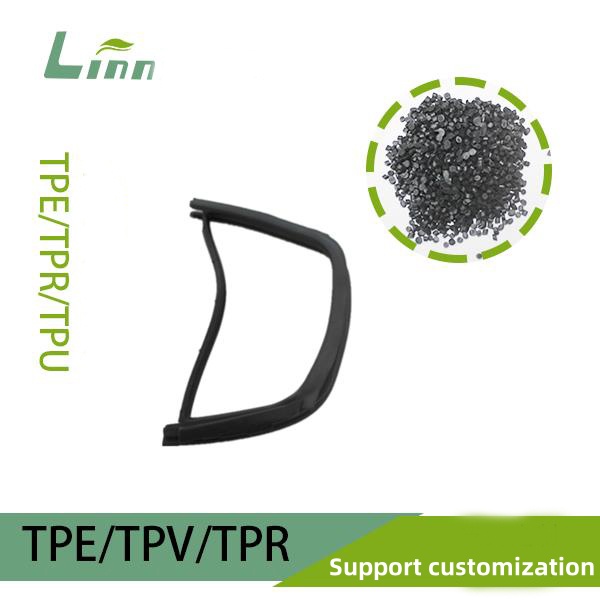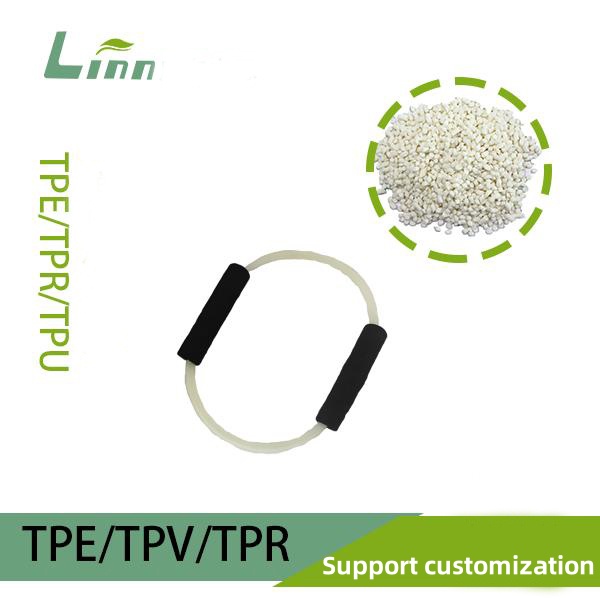Hey there! I’m a materials engineer at Linn, where I’ve spent the last 15 years knee-deep in the world of thermoplastic elastomers (TPE). If you’re here, chances are you’ve noticed something annoying: watermarks on your TPE products. Maybe it’s a yoga mat with weird streaks, a phone case with cloudy spots, or a sealing strip that just doesn’t look right. I’ve seen this issue pop up plenty of times, both in the lab and from folks reaching out to us at Linn. Today, I’m going to walk you through why these watermarks happen, what they mean, and—most importantly—how to fix them. Let’s get started!
What Are Watermarks on TPE, and Why Do They Show Up?
First off, let’s clear up what we’re talking about. Watermarks on TPE surfaces aren’t literal “water” marks in the sense of a spill. They’re usually those faint, uneven patches or streaks that appear after cleaning, drying, or even right out of the package. Sometimes they look like smudges; other times, they’re more like a hazy film. As someone who’s handled TPE for years, I can tell you this isn’t uncommon—but it can be frustrating.
So, why does this happen? From my experience, it boils down to a few key factors tied to TPE’s unique makeup and how it’s processed or treated. I’ve broken it down into the main culprits below, based on what I’ve seen in production and testing.

The Causes: Why TPE Gets Watermarks
TPE is a blend of rubber-like elasticity and plastic-like processability, which makes it awesome for tons of products. But that same combo can lead to surface quirks like watermarks. Here’s what I’ve found after years of tinkering and troubleshooting:
1. Residual Moisture and Drying Issues
TPE is often cleaned or cooled with water during manufacturing. If it’s not dried properly, tiny water droplets get trapped on the surface or soak into microscopic pores. When they evaporate unevenly, you’re left with those streaky marks. I’ve seen this a lot with extruded TPE parts—like sealing strips—where rushed drying leaves a patchy finish.
One time, I was at our Linn factory checking a batch of TPE mats. The drying oven was set too low, and sure enough, the surfaces had faint watermarks. Cranking up the heat and airflow fixed it right away.
2. Oil Migration from the Material
TPE recipes usually include plasticizing oils to keep them soft and flexible. Over time—or with heat—these oils can “sweat” to the surface, mixing with water or dust and leaving a greasy, watermark-like residue. I’ve noticed this more with lower-quality TPE that uses cheap oils, which tend to migrate faster.
I once tested a sample under a microscope and saw tiny oil beads forming on the surface after a week. Combine that with a splash of water, and you’ve got a recipe for smudges.

3. Surface Tension and Material Texture
TPE’s surface isn’t always perfectly smooth—it’s got micro-textures from molding or extrusion. Water doesn’t spread evenly across it because of surface tension, so it beads up in some spots and dries inconsistently. That’s why you might see watermarks more on matte finishes than glossy ones.
I’ve run my fingers over countless TPE samples, and the rougher ones always seem to hold onto watermarks longer. It’s just physics at play.
4. Contaminants or Cleaning Residues
If you’ve washed your TPE product with soap or a cleaner, leftover residue can dry into faint marks. Hard water’s a big offender too—minerals like calcium or magnesium leave behind white, chalky spots. I’ve had customers email me pics of their TPE yoga mats with these exact patterns after a rinse.
One client swore they’d only used water, but their tap was loaded with minerals. A quick switch to distilled water, and the marks stopped showing up.

What Do Watermarks Look Like? A Quick Breakdown
Not all watermarks are the same—they vary depending on the cause. Here’s a table I put together from my observations to help you pinpoint what you’re dealing with:
| Watermark Type | Appearance | Likely Cause | Common Products |
|---|---|---|---|
| Streaky Lines | Thin, uneven streaks | Poor drying after production | Sealing strips, tubing |
| Hazy Film | Cloudy, smudgy patches | Oil migration to surface | Yoga mats, soft grips |
| White Spots | Chalky, dotted marks | Hard water minerals | Washed TPE items |
| Beaded Patterns | Small, circular outlines | Surface tension on textured TPE | Matte-finished products |
This should give you a sense of what’s going on with your TPE item. For example, if you’re seeing white spots after cleaning, it’s probably not the material itself—it’s your water.
Are Watermarks a Problem?
Here’s the good news: watermarks are usually cosmetic, not functional. They don’t mean your TPE is damaged or unsafe. I’ve tested plenty of marked-up samples—flexibility, durability, all still spot-on. But I get it: looks matter. If you’re using TPE for something visible—like a phone case or a fitness band—those marks can be a buzzkill.
The only time I’d worry is if the watermarks come with stickiness or discoloration. That might signal oil bleeding out too much, which could point to a lower-grade TPE. At Linn, we run quality checks to keep that in check, but not every product out there gets the same TLC.
How to Remove Watermarks from TPE
Alright, let’s get to the fun part—fixing it! Over the years, I’ve picked up some solid tricks for tackling watermarks, whether they’re fresh from the factory or from your own cleaning attempts. Here’s what works:
1. Wipe with a Damp Cloth
Grab a soft, lint-free cloth, dampen it with warm water (not soaking wet), and gently wipe the surface. Dry it immediately with a clean towel to avoid new streaks. I’ve used this on Linn’s TPE mats, and it clears up most light marks in a minute.

2. Use Mild Soap
For stubborn marks—like oily ones—mix a drop of dish soap with warm water (under 104°F). Wipe the TPE with a cloth dipped in this, rinse with clean water, and dry thoroughly. I’ve had great luck with this on grips that got hazy from oil migration.
3. Try Distilled Water
If your tap water’s hard (loaded with minerals), switch to distilled water for cleaning. It won’t leave those white spots. I suggested this to a customer once, and they were amazed at the difference.
4. Air Dry Properly
After cleaning, don’t let TPE air-dry in a humid spot—water can pool and mark it again. Set it in a well-ventilated area or use a fan. I learned this the hard way when a batch of TPE parts dried slowly in a damp room and came out streaky.
5. Polish with a Dry Cloth
For a quick fix, buff the surface with a dry microfiber cloth. It can lift light watermarks and restore a uniform look. I keep a stack of these in my toolkit for spot checks.

Preventing Watermarks: Tips for the Long Haul
Fixing watermarks is one thing, but keeping them away? That’s the goal. Here’s what I’ve learned to keep TPE looking pristine:
Clean Smart: Stick to mild cleaners and avoid harsh chemicals that mess with the surface.
Dry Thoroughly: Always dry TPE completely after washing—don’t let water sit.
Store Right: Keep TPE products in a cool, dry place. Heat can pull oils to the surface, making marks more likely.
Quality Matters: Higher-grade TPE—like what we make at Linn—uses stable oils that don’t migrate as much, cutting down on watermark risks.
I’ve seen this play out in real time. A client once stored TPE seals in a hot warehouse, and the surfaces got oily and marked. Moving them to a climate-controlled spot solved it.
From the Factory: How We Minimize Watermarks at Linn
Since I’m on the inside at Linn, I’ll share a peek at how we tackle this in production. Watermarks aren’t just a user issue—they start with us. Here’s what we do:
Optimized Drying: We use precise heat and airflow to dry TPE parts evenly after water cooling.
Top-Notch Oils: We pick high-purity plasticizing oils that stay put, not ones that sweat out.
Surface Control: Our molds are designed for consistent textures that don’t trap water as easily.
I remember tweaking a drying process for a big order of TPE mats. The first run had faint streaks; the second, after adjusting the oven, came out flawless. It’s all about the details.

Final Thoughts: Watermarks Don’t Have to Stay
After all this, here’s my take: watermarks on TPE are annoying but fixable. Whether it’s a drying slip-up, oil migration, or hard water, you’ve got options to clean it up and keep it from coming back. As someone who’s spent years perfecting TPE, I’d say don’t sweat the small stuff—just grab a cloth and get to work. And if you’re picking new TPE products, brands like Linn have your back with quality you can see (and not see watermarks on!).
Got more questions? Hit me up below—I’m happy to chat!
FAQ Section
Q1: Can I prevent watermarks when cleaning TPE?
A: Yep! Use distilled water, mild soap, and dry it fully with a towel or good airflow. Works like a charm.
Q2: Do watermarks mean my TPE is low quality?
A: Not always. They’re usually surface-level and cosmetic. But if they’re oily or sticky, it might hint at cheaper materials.
Q3: How long does it take to remove watermarks?
A: Light ones? A quick wipe—maybe 5 minutes. Tougher marks might need a soap wash and drying, so 15-20 minutes tops.
Q4: Why do some TPE products never get watermarks?
A: It’s about the recipe and process. High-quality TPE—like Linn’s—uses stable ingredients and better drying, so marks are rare.





